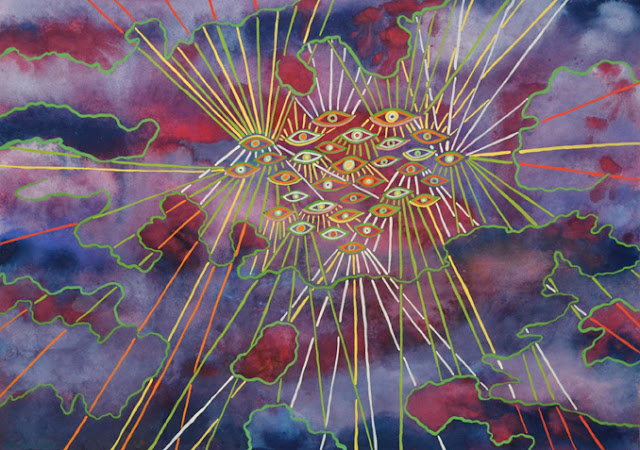Occupied Landscape: Everywhere Oil on canvas 76 x 76 cm 2018
Occupied Landscape: Everywhere continues my interest in proposing that new topographies are being imposed upon our Earthly, biospheric and near-space landscape. These new topographies are not necessarily visible. Nodes, such as drones, mobile phones, ground control stations and satellites, may be visible, but the signals that connect them are not. With increasing dual-use capabilities of contemporary digital and cyber technologies, the prospect of an insidiously militarised landscape/environment cannot be ignored. This kind of occupation of landscape by signals could indicate a global ever-readiness for war, offensive and defensive, rather than just isolated cases of war and conflict.
In Occupied Landscape: Everywhere a weaponised drone loiters - hovers. Its pixelated appearance denotes its connection to digital technologies. The grids of red and white lines reveal a new netted layer over the landscape. In the title I use the word 'everywhere', drawing upon geographer Derek Gregory's ideas of the 'everywhere war'. This, of course, does not just mean everywhere geographically. It can also mean the everywhere of time, and cyberspace.
In Occupied Landscape: Everywhere a weaponised drone loiters - hovers. Its pixelated appearance denotes its connection to digital technologies. The grids of red and white lines reveal a new netted layer over the landscape. In the title I use the word 'everywhere', drawing upon geographer Derek Gregory's ideas of the 'everywhere war'. This, of course, does not just mean everywhere geographically. It can also mean the everywhere of time, and cyberspace.
NEWS
I have just returned from a stimulating two day workshop "Art + Conflict" hosted by the Institute of International Law and Humanities, Melbourne University Law School, and the Victorian College of the Arts, also at the University of Melbourne. It was a cross-disciplinary workshop, and a successful cross-disciplinary one! People from the Humanities, Law and Arts attended and spoke. Academics, curators and artists were also there, many wearing multiple hats. Four young academic scholars organised the workshop, Federica Caso [Uni of Queensland], Ms Shawna Lesseur [University of Connecticut], Stacey Vorster [Wits/UvA], Laura Petersen [University of Melbourne].
I was invited to be on the plenary panel [photo below], along with Prof Paul Gough, visual artist and Pro Vice-Chancellor and Vice-President in the school of Design and Social Context, RMIT, and Ryan Johnston who is the inaugural Director of Buxton Contemporary at the VCA, University of Melbourne. Ryan is also the immediate past Head of Art and the Australian War Memorial.
L to R:
Prof Paul Gough, panel provocateur Fedrica Caso, Kathryn Brimblecombe-Fox, Ryan Johnston.
Photo: Connor Foley [Institute of International Law and Humanities, University of Melbourne Law School]
A highlight was to hear Prof Desmond Manderson speak [photo below]. He is the Director, Centre for Law, Arts and Humanities, Australian National University College of Law. He spoke about Raphael Cauduro's murals in a stairwell in the Supreme Court of Justice building, Mexico city. The stairwell is used by judges to access their offices from the carport. It is also accessed by tour groups visiting the court building. Manderson's presentation brought to life the ghosts Cauduro had provocatively painted in replays of atrocious injustices.
Prof Desmond Manderson. Image on screen section of stairwell where Raphael Cauduro's murals are painted, Supreme Court building, Mexico.Photo: Connor Foley [Institute of International Law and Humanities, University of Melbourne Law School]
Cheers,
Kathryn


















